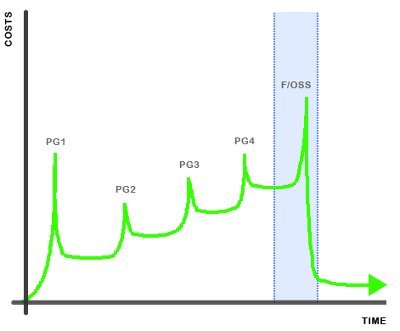The open source sea change and the Taylor graph


It is meant to illustrate the costs of "upgrading" from a proprietary to a Free and Open Source Software (FOSS) solution in your IT shop.
It seeks to blunt what you might call the tip of the Microsoft spear, its chief argument against open source in the enterprise.
That argument, Taylor writes, is that that the switching costs will kill you.
Looking less like science than a child's scrawl, Taylor's graph actually shows costs peaking with each upgrade cycle, including a switch to open source. But note that immediately after that peak costs drop a lot, and stay down over time.
While I'm as big an open source advocate as anyone I don't buy this -- at least not for enterprise customers.
An enterprise must maintain paid staff, and I think that staffing must be increased after a switch to open source, if you want to keep your installation current.
This increase is modest, I believe, and more than offset by the higher licensing costs of proprietary solutions against the support costs of open source. But it's real, and we should not ignore it.
In fact we should embrace it.
When an enterprise goes with open source they become part of a larger community, consisting of everyone else using that solution. This community may indeed include competitors. But it's not just competitors.
Gaining an advantage in this open source competition requires that you be the best community member you can be.
The more you let your people participate in forums, the more code they contribute, the more valuable they become to you and the more up-to-date your system becomes.
Signing a support subscription contract is not the same thing as buying software. It's less a buyer-seller relationship than a student-teacher relationship.
Once you accept this and build it into your budget you will get the maximum bang for every open source buck you spend. Just not before. This is the open source sea change, the biggest impact of a company successfully adopting open source.
What does your open source experience tell you?